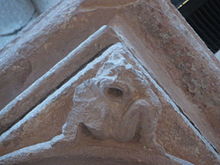Additional information
| Weight | 500 g |
|---|---|
| Dimensions | 12 × 18 × 10 cm |
£18.50
No Home Should Be Without One – Wonderful Sandstone Cement Frost proof Replicas 12 x 8cm
from Wikipedia
A sheela na gig is a figurative carving of a naked woman displaying an exaggerated vulva. These carvings, from the Middle Ages, are architectural grotesques found throughout most of Europe[1][2] on cathedrals, castles, and other buildings.
The greatest concentrations can be found in Ireland, Great Britain, France and Spain, sometimes together with male figures. Ireland has the greatest number of surviving sheela na gig carvings; Joanne McMahon and Jack Roberts cite 124 examples in Ireland[3] and 45 examples in Britain.[4] One of the best examples may be found in the Round Tower at Rattoo, in County Kerry, Ireland. There is a replica of the Round Tower sheela na gig in the County Museum in Tralee town. Another well-known example may be seen at Kilpeck in Herefordshire, England.
The carvings may have been used to ward off death, evil and demons.[1][2] Other grotesque carvings, such as gargoyles and hunky punks, were frequently part of church decorations all over Europe. It is commonly said that their purpose was to keep evil spirits away (see apotropaic magic). They often are positioned over doors or windows, presumably to protect these openings.

Scholars disagree about the origins of the figures. James Jerman and Anthony Weir believe the sheela na gigs were first carved in France and Spain during the 11th century; the motif eventually reached Britain and then Ireland in the 12th century.[2] Jerman and Weir’s work was a continuation of research begun by Jorgen Andersen, who wrote The Witch on the Wall (1977), the first serious book on sheela na gigs.[1] Eamonn Kelly, Keeper of Irish Antiquities at the National Museum of Ireland in Dublin, draws attention to the distribution of sheela na gigs in Ireland to support Weir and Jerman’s theory;[5] almost all of the surviving in situ sheela na gigs are found in areas of Anglo-Norman conquest (12th century). The areas which remained governed by native Irish have few sheela na gigs.[5] Weir and Jerman also argue their location on churches and the grotesque features of the figures, by medieval standards, suggests they represented female lust as hideous and sinfully corrupting.[2]
Another theory, espoused by Joanne McMahon and Jack Roberts, is the carvings are remnants of a pre-Christian fertility or mother goddess religion.[4] They note what they claim are differences of materials and styles of some sheela na gigs from their surrounding structures, and noting some are turned on their side, to support the idea they were incorporated from previous structures into early Christian buildings.[citation needed]
| Weight | 500 g |
|---|---|
| Dimensions | 12 × 18 × 10 cm |